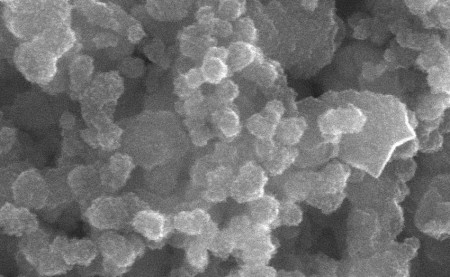Jul
8
A New Process to Make Low Cost Photovoltaic Solar Cells
July 8, 2013 | 1 Comment
Engineers at Oregon State University (OSU) have developed a new process combining some comparatively low cost materials and automotive antifreeze that may be the key to making solar cells that cost less and avoid toxic compounds, while further expanding the use of solar energy.
When the process is perfected the technique might also cook up the solar cells in a microwave oven similar to the one in most kitchens. (See the meso-fluidic reactors link in the paragraph below.)

Nanoparticles of Copper Zinc Tin Sulfide Processed with Antifreeze Solvent. Click image for the largest view.
The research paper has just been published in Material Letters. The paper concludes the approach will work with copper zinc tin sulfide, or CZTS, a compound of significant interest for solar cells due to its excellent optical properties and the fact these materials are cheap and environmentally benign.
The Oregon engineers have determined that ethylene glycol, commonly used in antifreeze products, can be used as a low-cost solvent that functions well in a “continuous flow” reactor – an approach to making thin-film solar cells that is easily scaled up for mass production at industrial levels.
Greg Herman, an associate professor in the OSU School of Chemical, Biological and Environmental Engineering said, “The global use of solar energy may be held back if the materials we use to produce solar cells are too expensive or require the use of toxic chemicals in production. We need technologies that use abundant, inexpensive materials, preferably ones that can be mined in the U.S. This process offers that.”
Compare to today’s common production that is made with copper indium gallium diselenide, or CIGS. Indium is comparatively rare and costly, and mostly produced in China. Last year, the prices of both indium and gallium used in CIGS solar cells were about 275 times higher than the zinc used in CZTS cells. Its little wonder most low cost solar cell production comes from China and it’s a situation that unnerves investors business managers and consumers.
The new technology being developed at OSU uses ethylene glycol in meso-fluidic reactors that can offer precise control of temperature, reaction time, and mass transport to yield better crystalline quality and high uniformity of the nanoparticles that comprise the solar cell – all factors which improve quality control and performance.
The new approach is also faster. Many companies still use “batch mode” synthesis to produce the CIGS nanoparticles, a process that can ultimately take up to a full day, compared to about half an hour with a continuous flow reactor. The additional speed of such reactors will further reduce final costs.
Professor Herman points out an important element in solar cell production, “For large-scale industrial production, all of these factors – cost of materials, speed, quality control – can translate into money. The approach we’re using should provide high-quality solar cells at a lower cost.”
For now the performance of CZTS cells is lower than that of CIGS, researchers say, but with further research on the use of dopants and additional optimization it should be possible to create solar cell efficiency that is comparable. That is a likely potential result with more work. Ultimately the cost savings during production are going to matter most. Photovoltaic is still way too expensive for net useable energy.
This project is one result of work through the Center for Sustainable Materials Chemistry, a collaborative effort of OSU and five other academic institutions, supported by the National Science Foundation. Funding was provided by Sharp Laboratories of America. The goal is to develop materials and products that are safe, affordable and avoid the use of toxic chemicals or expensive compounds.
Many folks justifiably long for grid parity energy production at home and business sites. Photovoltaic, when the development reaches the technology level needed, will be welcome, indeed. Lets hope the competition and research for the current conversion keeps in pace. It would be a sad fact if solar cell technology gets ready and the solar produced Direct Current couldn’t be cheaply, reliably converted to Alternating Current.
Comments
1 Comment so far


You have made some really good points there. I checked on the web to learn more
about the issue and found most individuals will go along with your views on this web site.